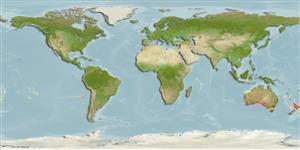Common names from other countries
Environment: milieu / climate zone / depth range / distribution range
Écologie
marin récifal; profondeur 0 - 400 m (Ref. 58302), usually 15 - 60 m (Ref. 30464). Subtropical; 19°S - 42°S, 114°E - 76°W
Eastern and western South Pacific: Exact distribution unknown because of taxonomic uncertainties.
Taille / Poids / Âge
Maturity: Lm ? range ? - ? cm
Max length : 55.0 cm FL mâle / non sexé; (Ref. 89444); common length : 30.0 cm TL mâle / non sexé; (Ref. 30464)
Épines dorsales (Total): 10; Rayons mous dorsaux (Total): 19-21; Épines anales 3; Rayons mous anaux: 7 - 9; Vertèbres: 26. Lateral line scales of individuals in the eastern Pacific is 58-65, in western Pacific 61-71 (Ref. 120532). Monochromatic orange-red or with black spots on the dorsal fin (Ref. 43805). Congruent rays of the dorsal fin and a caudal fin with a deep median notch in both sexes (Ref. 43805). Preopercle serrate, but without antrorse spines (Ref. 40817).
Occurs inshore near reefs (Ref. 7300). Benthopelagic and benthic (Ref. 58302). Feeds on plankton and small nekton. Occasionally caught on small hooks when fishing in midwater without sinker and make excellent eating (Ref. 30464). Its abundant gillrakers and stomach contents characterize it as an opportunistic pelagic polyphagic-zooplanktivorous predator (Rojas et al. 1998a, c) (Ref. 89357).
Life cycle and mating behavior
Maturité | Reproduction | Frai | Œufs | Fécondité | Larves
Paxton, J.R., D.F. Hoese, G.R. Allen and J.E. Hanley, 1989. Pisces. Petromyzontidae to Carangidae. Zoological Catalogue of Australia, Vol. 7. Australian Government Publishing Service, Canberra, 665 p. (Ref. 7300)
Statut dans la liste rouge de l'IUCN (Ref. 130435)
CITES (Ref. 128078)
Not Evaluated
Menace pour l'homme
Harmless
Utilisations par l'homme
Plus d'informations
Noms communsSynonymesMétabolismePrédateursÉcotoxicologieReproductionMaturitéFraiFéconditéŒufsDéveloppement de l'œuf
RéférencesAquacultureProfil d'aquacultureSouchesGénétiqueElectrophoresesHéritabilitéPathologiesTraitementMass conversion
CollaborateursImagesStamps, Coins Misc.SonsCiguateraVitesseType de nageSurface branchialeOtolithesCerveauxVision
Outils
Articles particuliers
Télécharger en XML
Sources Internet
Estimates based on models
Preferred temperature (Ref.
115969): 16 - 23.2, mean 17.9 (based on 250 cells).
Phylogenetic diversity index (Ref.
82804): PD
50 = 0.6250 [Uniqueness, from 0.5 = low to 2.0 = high].
Niveau trophique (Ref.
69278): 3.9 ±0.63 se; based on food items.
Résilience (Ref.
120179): Faible, temps minimum de doublement de population : 4,5 à 14 années (Preliminary K or Fecundity.).
Fishing Vulnerability (Ref.
59153): Moderate vulnerability (44 of 100).
